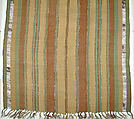Wrapper
Not on view
Textiles woven from raffia fibers were produced by Sakalava women along the east coast of Madagascar. Rougher fabrics were created for utilitarian purposes, the largest serving as mosquito netting, while finer weaves were reserved for clothing. Both men and women used a single piece of cloth to cover themselves, either draping it over the shoulders or wrapping it around the chest. Women often wore long wrappers that fell to the ankles, creating a garment of great elegance and distinction.
The striped patterns of this raffia cloth appear deceptively simple and straightforward, but closer examination reveals their complexity. The juxtaposition of light and dark, thick and thin runs in various permutations across the width of the material, lending it a vibrancy and dynamism that transcends the simple green, brown, and natural tan palette from which it is composed.
Due to rights restrictions, this image cannot be enlarged, viewed at full screen, or downloaded.

